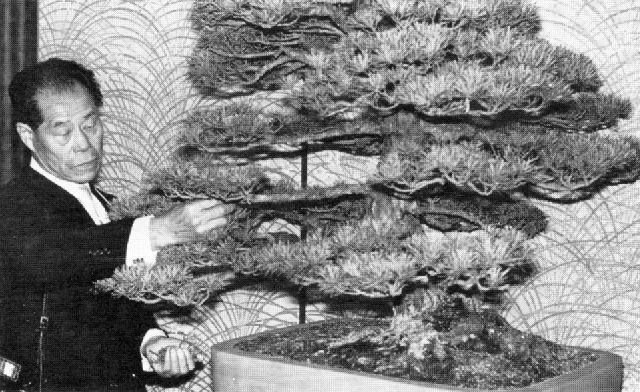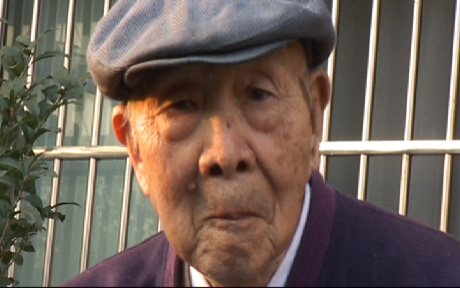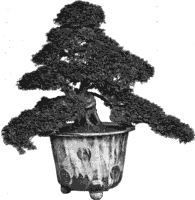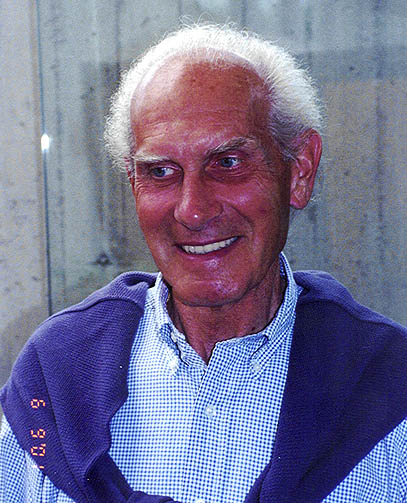| 21 |
|
| 22 |
1975 -- The Massachusetts Horticultural Society in Boston presented
John Naka with their Thomas Roland Medal for his unstinting and
generous efforts for over 25 years to spread the knowledge of bonsai
throughout the United States and for bringing this field of
horticulture to a superior degree of art and refinement.
(Elias, Thomas S. "John Yoshio Naka: The Life and Times of the Bonsai Master,"
Bonsai Magazine, BCI, Vol. 44, No. 1, January/February/March 2005, pg. 13) SEE ALSO: Oct 5
2010 -- The inaugural two-day exhibit of Sabi Bonsai Kai was held at the Asheville, North Carolina Civic Center. The show featured 94 individual displays. The group was formed by Warren Hill and modelled in a similar fashion to the John Naka group Nanpu Kai. During John's lengthy tenure as President of the California Bonsai Society he founded Nanpu Kai as a tribute to his best students. One of John's dreams was to have each of the Nanpu Kai members form their own group. Sabi Bonsai Kai is intended as one of those groups. It is fitting that the judge for the first Sabi Bonsai Kai Exhibit was the current president of Nanpu Kai, Mel Ikeda. (Sabi Bonsai Kai is a dream that took more than two years to realize. Organizers Warren Hill, Mike Dietz and Mike Blanton then spent a considerable amount of time finding the perfect location for the first exhibit. The show highlighted masterpiece quality bonsai and was designed to promote the art of bonsai in the mid-south area of the U.S.) (Berenberg, Matt "Sabi Bonsai Kai Exhibition: in the spirit of Saburo Kato," Bonsai Focus, 130/107, 6/2010, Nov/Dec, pg. 85) SEE ALSO: Nov 27 |
| 23 |
1899 -- A two-day Exhibition of a Rare and Beautiful Collection of Japanese Floral and Arboreal Plants was
begun today at the American Art Galleries, Madison Square South in New York. The auction was held for
Kushibiki & Arai with the assistance and contributions of Count Okuma (6) and Mr. Otori (4), both of Tokyo.
In the Japanese tea house built in the art gallery for this event, a number of plants were shown, along with a
12 total miscellaneous: bronze jardinieres, a bronze crane, garden screen, garden statue, and large stone or
porcelain lanterns. A Japanese garden gate was also present. Some 74 Chabo-hiba (Chamaecyparis
obtusa), 60 maples, 26 pines, 7 Sago palm compositions, 5 Podocarpus, 3 Punicas, and 6 orchids are listed,
among others including ferns, sweet ferns, zelkovas, junipers, cryptomerias, larch, pyrus, rhodea, jasminum,
rhapis, rhus, oak, enkyanthus, cleyera, and wisteria. About two dozen of the compositions are specifically
labelled as bonkei, miniature landscapes on a tray, often with rocks. The largest specimen was an
85-year old 7' tall Chisho maple in a native wooden pot. The pots listed were native wood (128 each),
Shigaraki/Shijaraki (14), Seto (13), Ruri (4), Karatsu (6), Seiji (7), Hibiyaki (4), Kozan (1), Ude (2), Kenzan
(1), Imari (2), Akahada (12), Oribe (1), Shude (7), Shide (3), Blue and white (18), Corean ware (2), Chinese
Kinyo (1), Kishu (1), plus several assorted others. A free viewing of all 301 items was allowed between May
19th and the day of the sale. Per the 117-page auction catalog featuring 31 illustrations of 36 of the
items: "In order to aid those not familiar with the proper care of Japanese plants, Messrs. Kushibiki
& Arai will, without other charge than traveling expense, send an experienced Japanese gardener to any place
within fifty (50) miles of New York City, who will give the necessary attention to those plants that will be
designated at the time of sale, and will also, where it is possible, replace any plant that is beyond restoring
to the same healthy condition as it was when sold."
"300"
From page 101 the description of this specimen (picture from the page before the title page) is as follows:"This tree has an Authentic History of nearly 850 years." The handwritten note underneath "Bro't $1,600.00" which apparently means the tree was sold for the equivalent of $61,648.00 in 2025 USD "300A Chabo-Hiba, From a historical point of view and from a point of view of great age this tree is by long odds the most interesting of all those exhibited. The authentic history of this famous Chabo-Hiba dates away back to the middle of the 12th century -- the beginning of the Kamakura period -- when the art of gardening received a great impulse at the hands of the Buddhist priests. In one of the Kamakura temples it was guarded with all the care that could possibly be given it. Through the Shogun Regency and all the history making times of Japan this plant was as carefully preserved as any heirloom could possibly be. A very long time before the downfall of the Shogun the family of Tagaki, of Tokio, was appointed by Shogun as gardeners having in charge the garden of the Temple in which was this famous Chabo-Hiba. At the downfall of the Shogun about thirty-three years ago, it passed into Mr. Tagaki's possession. We secured it for this exhibition. Mr. Tagaki is with us at this exhibit, and will gladly answer any questions you may ask about the tree. The height of this marvelous tree is a little over six feet, the diameter of the trunk is about one foot. Is a graceful conical shape. The jardiniere is of Chinese ware. (See illustration.)" NOTE. -- The purchaser of this tree may have the services of a Japanese gardener free of all charge excepting railroad fare, for a year if desired. We will furnish an expert gardener, who will teach your own [sic] the art of caring for Japanese plants." We have no idea what was the actual fate of this grand old specimen but, unfortunately, we can probably guess... (American Art Association, Auction Catalog, pp. 6, 9, 101; "Inflation Calculator, https://www.in2013dollars.com/us/inflation/1899?amount=1600) SEE ALSO: Nov 15 1987 -- The first three-day Spring Rendezvous was held at Brussel's Bonsai Nursery in Olive Branch, MS. Ben Oki was the workshop instructor. [Brussel Martin's annual Rendezvous would then be held on the Memorial Day week-end and eventually have several national and international-class instructors for multiple workshops at each event. Workshop material would be chosen from plants in the over 100,000 sq. ft. (after 2005) of computer-monitored greenhouse space on the property watered by their own wells.] ("Brussel's Bonsai Nursery," http://www.youtube.com/watch?v=AmyRdflQu-g; Covington, Jimmie "Brussel's Nursery is place for bonsai," May 25, 2008, http://www.commercialappeal.com/news/2008/may/25/bonsai-to-behold-brussels-nursery-is-place-for/?feedback=1; Steve Alford, Pikes Peak Bonsai Society participant at 2010 Rendezvous in conversation with RJB 12 June 2010.) SEE ALSO: May 15 |
| 24 |
2007 -- Yuzy Sato died at the age of 85. (After Yuzy was interned (1942) in the
Jerome, Arkansas relocation camp, he studied
horticulture and received his B.A. in that field from Colorado A&M. Yuzy and Toy were married in 1948
and had 4 children. Yuzy became
interested in stones when he joined the Palos Verdes Gem and Mineral Society
in 1958 and was its president the next year. He went on monthly collecting trips although at that time his
interest was primarily lapidary. He was accomplished at gemstone faceting and had a large
collection of favorites. Toy and Yuzy's interest in viewing stones soon followed.
He and Toy were founding members of California Aiseki Kai.
Yuzy opened a wholesale nursery in LA County. The nursery business may have been his vocation
but stones were his avocation. Stone-collecting gave him a great deal of pleasure after he
retired. He had a complete workshop where he made all the daiza for his and Toy's
extensive collection of stones. The Sato's have a stone in
the National Collection in Washington, D.C.)
(Obituary in California Aiseki Kai's newsletter, Vol. 25, Issue 6, June 2007, pg. 7, http://www.aisekikai.com/resources/june+newsletter+07.pdf.) SEE ALSO: May 2, Dec 28 |
| 25 |
1990 -- The two day first International Bonsai Symposium opened in
Prague, Czech Republic. Pius Notter and Harry Tomlinson, among others,
demonstrated for two hundred and five delegates from ten European nations.
("The Bonsai Trees of Nowadays" by Blahoslav Lukavec,
Bonsai Magazine, BCI, March/April 1991, pp. 3-5.) : SEE ALSO: Mar 2
2006 -- Japanese master Shinji Ogasawara died. (Ogasawara was born in Hokkaido in 1918, and his family moved to Tokyo during his childhood. At age 15 he was sent out to serve as an apprentice for Tomekichi Kato's Mansei-en bonsai nursery in Omiya. He learned his bonsai fundamentals from Tomekichi and also from the Kato sons, Saburo and Hideo. After serving five years of military service, in 1945 Ogasawara returned to bonsai as a livelihood by making "house calls" to his bonsai customer's dwellings to wire, prune and shape trees for a fee. By 1948, he had established his own bonsai nursery called Seifu-En ("Green Wind") at Takeyama near the ocean. A decade later Ogasawara was elected Director of the Nippon Bonsai Kumiai (Bonsai Nurserymen's Union). Four years after this he moved his nursery Seifu-En to Omiya since the ocean air and strong winds at the Tateyama location were proving unfavorable to good bonsai growing and maintenance. From 1979 to 1984, Ogasawara served as Chairman of the Board of Directors of the prestigious Nippon Bonsai Kyodo Kumiai (Bonsai Nurserymen's Cooperative). Elected Standing Director of the Nippon Bonsai Kyokai, he joined the editorial committee of Bonsai Shunju, its monthly magazine in 1982. Seven years later he became Chief Editor of that periodical. In April 1982, the California Bonsai Society's Silver Anniversary was celebrated and Ogasawara used one of Harry Hirao's famous California junipers for his demonstration there. Two years later for a joint BCI-ABS convention in Seattle, WA, Ogasawara was the featured demonstrator, creating a semi-cascade five-needle pine. In the four years since 1986, Ogasawara was invited four times to demonstrate in Italy at the request of Luigi Crespi. That year also saw Ogasawara and John Naka making a demonstration tour of Barcelona and Valencia, Spain. And Ogasawara demonstrated in Pakistan as a guest of the Karachi Bonsai Association in 1987.) 
"Mr. Shinji Ogasawara of Japan, doing a little grooming at the
(Personal e-mail to RJB from Bill
Valavanis, 20 Jun 2006; Tsukiyama, Ted T. "A Bonsai Portrait of Shinji Ogasawara,"
Bonsai, BCI, Vol. XXIX, No. 3, May/June 1990, pg. 24.)
Japanese Embassy [in Washington, D.C.]." (Bonsai Magazine, BCI, Vol. XXV, No. 6, November/December 1986, pg. 19) 2006 -- Master Xu Xiaobai of the Yangzhou school of penjing died at age 97. (Personal e-mail to RJB from Lindsay Farr, 14 Jun 2006, which gives age as 98; screen shot below from episode 3 of World of Bonsai series sent to RJB by Farr, 4 Dec 2006, portrait taken 3 years earlier) SEE ALSO: Mar 15, Apr 20 
|
| 26 |
1898 -- Some 500 Japanese dwarf trees were sold during the earliest known auction of bonsai in the West, a two-day event beginning today
in New York City. The subjects that composed the bulk, and which commanded the biggest figures, were Thuya obtusa,
Podocarpus macrophylla, Sciadopltys verticillata, Buxus japonica variegata, Larix leptolepls, Rhapis humilis, and
trained Maples. One of these last, an Acer palmatum, realized $117.50, and the tree was not 40 inches in height.
[The auction would realize about $10,000.]
"THUYA OBTUSA. (JAPANESE NAME
CHABO HIBA.)
(http://www.magiminiland.org/1800Refs/American.html; per
https://www.in2013dollars.com/us/inflation/1898?amount=10000, the relative worth of
$117.50 from 1898 would be $4,527.27 in 2025 using the CPI Inflation Calculator, while the relative worth of $10,000 would be
$385,300.00, and $330 would be $12,714.90.) SEE ALSO: May 4, Nov 6, Nov 15
Height of plant, 42 Inches; age, 215 years. Sold for $330." 1971 -- The premier of "Bonsai -- the Art of Training Dwarfed Potted Trees" was held at the Brooklyn Botanic Garden. The new color-sound film was produced, directed, and photographed by Ian Clark for the BBG and was the Garden's third educational film. Frank Okamura is the uncredited demonstrator on the 16 mm format, 21 minute long film. (Bonsai Journal, ABS, Summer 1971, pp. 33-34) SEE ALSO: May 5 1991 -- The Crespi Bonsai Museum opened in northern Italy, in Parabiago not far from Milan. This first permanent museum of bonsai trees from all over the world is a result of Luigi Crespi's enthusiasm and thirty-year work in the world of bonsai and Japanese garden. It originated from the willingness to offer to bonsai enthusiasts the opportunity to admire a precious collection that includes centuries-old plants, antique pots and books and manuscripts from the Far East. The masterpiece of the collection is the millenary Ficus retusa Linn, placed at the centre of a glass pagoda, which is dedicated to Chinese penjing and contains also many old trees of tropical and sub-tropical species, like a beautiful Murraya paniculata (300 years old). In the outdoor gallery, on tables of solid black slate, many other authentic works of art are displayed; some of them are well over hundred years of age, trained by famous Japanese masters as Kato, Kawamoto, Kawahara and Ogasawara. Among them a rare Acer palmatum kashima and a very old Juniperus chinensis, characterized by amazing natural shari on the trunk. The master Nobuyuki Kajiwara has been taking care of the development of the Crespi Bonsai Museum masterpieces since the museum's establishment, and he is also teacher of bonsai art at the Crespi Bonsai University (est. 1991). Students follow his lectures and workshops sitting in the great hall, equipped with audio-visual device, facing the stone garden and the museum gallery. [In 2009, the museum's collection would be enriched by some special masterpieces coming from the famous collection of the WBFF honorary chairman, Mr. Daizo Iwasaki (who passed away in May 2011). Among these additions would be a semi-cascading Miyajima White Pine placed in a beautiful reproduction of a very famous antique pot from the classic China. The collection of bonsai pots here would include antique Chinese containers from the Ming and Ching dynasties.] 
Luigi Crespi, 06/09/01.
("Crespi Bonsai Museum," http://www.grandigiardini.it/EN/scheda.php?id=137)
SEE ALSO: Mar 19, May 15, May 25, Oct 8.
(Photo courtesy of Alan Walker, 05/11/07) |
| 27 |
|
| 28 |
2005 -- From today through Sept. 6, the Smithsonian's Freer Gallery
of Art and Arthur M. Sackler Gallery presented a special exhibit of
eight antique Chinese Pots for Tabletop Gardens. Honoring the
World Bonsai Friendship Federation convention in Washington, D.C., this
featured pots from the I. C. Su Collection. Two of the containers
were from the Ming dynasty (1368 - 1644), three from the Qing (1644 -
1911; two partly of gilt metal), one from the Jin (13th century+), and
two were undated. See
description
here.
(See Also "Fine Chinese Ceramics Imperial Ware," Bonsai Journal, ABS, Vol. 38, No. 4, Winter 2004, pp.
22-22, with 5 color photos)
2011 -- Starting today and running through June 5, an exhibition of trees was held in the Moscow Timiryazev Museum, offered by a few members of the National Bonsai Club. Most of the exhibits featured local yamadori found by the members during the past few years. Photos of some of the trees can be seen here. One of the members was Andrei Darusenkov, a bonsai artist who has been practicing this since the mid-1990s. He repeatedly visited Japan to study this ancient oriental art. In 2005, 2006 and 2009, the trees designed by him were awarded at international bonsai competitions. Since 2003, he has been regularly holding exhibitions of his works and master classes on various techniques of bonsai formation both in Moscow and in St. Petersburg, Vladimir, Suzdal, and other cities of Russia. He is the author of many publications and a number of television programs about the art of creating and maintaining miniature trees. His collection of includes over 200 bonsai trees at various stages of formation. He is a supporter of the creation of bonsai from traditional Russian trees, such as birch, elm, hornbeam, oak, larch, juniper, pine, spruce, etc. ("Exhibition of bonsai in Moscow, May 28-June 5, 2011," Internet Bonsai Club posts by Andrei Darusenkov, May 30, 2011; "Seminars of Andrei Darusenkov, 9 March 2017) SEE ALSO: Jun 17, Nov 26 2016 -- Long-time Internet Bonsai Club moderator Jim Lewis died at age 78 at his home, surrounded by his wife Jackie and other family members. He had had an extended battle with a lung condition that most of his associates were never aware of. (His last visit to the IBC forum had been on May 4 when he posted what would be the final of his 8060 thoughts to that group. That number was more than the next two most represented commenters combined, and this count was just since the latest reboot of the forum's server took place in January 2009. In his usual gruff but patient and tolerant manner, he was always straight to the point and a fount of helpful advise.) (Personal e-mail to RJB from Chris Cochrane, 05/29/16; postings by John Quinn and others on IBC thread "RIP Jim Lewis," 05/30/16; Memberlist query 05/30/16.) SEE ALSO: Sep 3 |
| 29 |
1971 -- The World's First International Bonsai Convention and Show
was opened by the Brooklyn Botanic Garden's Frank Okamura in Cleveland
Ohio, sponsored by Bonsai Clubs International and co-hosted by the Cleveland
and Toronto Bonsai Societies.
("The Cleveland Bonsai International,"
Bonsai, BCI, July/August 1971, pg. 6) SEE ALSO: May 5, Jan 30, Feb 28
1991 -- Uganda issued a set of ten postage stamps to commemorate Phila Nippon '91. Walt Disney characters are in various traditional Japanese settings. One of the stamps, which shows Mickey Mouse removing his shoes before entering Minnie's house, has a sinuous trunked bonsai as a decoration on the engawa to the left of Minnie. A second stamp, showing Clarabelle Cow enjoying incense burning, has a larger informal upright bonsai behind her table. A third stamp of interest to us shows Mickey and Minnie enjoying New Year's card and letter writing. Right of center along the bottom edge of this stamp are three layers of foliage which must belong to a bonsai just out of the frame. SEE ALSO: Jan 23, Jan 29, Feb 3, Feb 16, Mar 1, Mar 27, Mar 31, Apr 3, Apr 6, Apr 18, May 6, Jun 16, Jul 20, Aug 20, Aug 22, Sep 22, Oct 1, Oct 4, Dec 9. 2022 - Mário Alberto Garcia Leal died this day in Brazil at age 77. (He had begun his own studies in bonsai in 1990, about five years later he started working with penjing, and after a 1998 workshop with Qingquan Zhao, Mário became a specialist in penjing. That Christmas he gave his first bonsai course. In 2004 he established his website, www.atelierdobonsai.com.br. Beginning in 2006 he held an annual event at the nursery at his home hosting friends from all over Brazil and abroad. He lived in Ribeirão Preto in São Paulo state in southeast Brazil. This largest event of its kind in the nation and without any commercial or association support included teachers such as Roy Nagatoshi (USA), Suthin Sukosolvisit (USA-Thailand), Morten Albek (Denmark), Václav Novák (Czech Republic), Charles Ceronio (South Africa), Marita Gurruchaga (Argentina), Chase Rosade (USA), Vladimir Ondejcík (Slovakia), Bernie O'Callaghan (Namíbia), Louis Nel (South Africa), Nacho Marin (Venezuela), Pedro Morales (Puerto Rico), Rui Ferreira (Portugal), Rob Kempinski (USA), German Arellano (Colombia), and Peter Chan (UK). In return, he appeared at Club de Bonsai Bolivia in La Paz, Bolívia (1999), Bonsai Slovakia International Bonsai, Suiseki, and Tea Exhibition in Nitra, Slovakia (2003 and 2010), SABA (South African Bonsai Association) in Pretória, South Africa (2009), Museu de Bonsai in Sintra, Portugal (2010), AUBO (Asociación Uruguaya de Bonsai) in Montevidéo, Uruguay (2010), 6° Oji Tarptautine Bonsai and Suiseki Paroda in Vilnius, Lithuania (2011), International Cancer Day Bonsai Exhibition in Windhoek, Namíbia (2012), Associación Arequipeña de Bonsai in Arequipa, Peru (2012), and Bonsai Argento in Tapiales, Argentina (2013). At all of these events Mário developed many deep friendships. This teacher was one of the main popularizers of bonsai and penjing in Brazil. He wrote Penjing landscape - Water-and-Land in Portuguese and English in 2007, ABC do Bonsai in Portuguese in 2011, and two years later Osamu Hidaka, A História de um homem e seus Pinheiros-Negros in Portuguese. Mário was also a musician.) (Facebook post on 05/29/22 by Bergson Vasconcelos and a comment in that post by José Martins Fernandes ; "Bonsai Profile, Mário A G Leal," Bonsaiempire.com; Palhano, Thereza "Bonsai no Brazil - Mario AG Leal - 08/12/2016," mybonsai.com) SEE ALSO: Apr 1 |
| 30 |
|
| 31 |
|